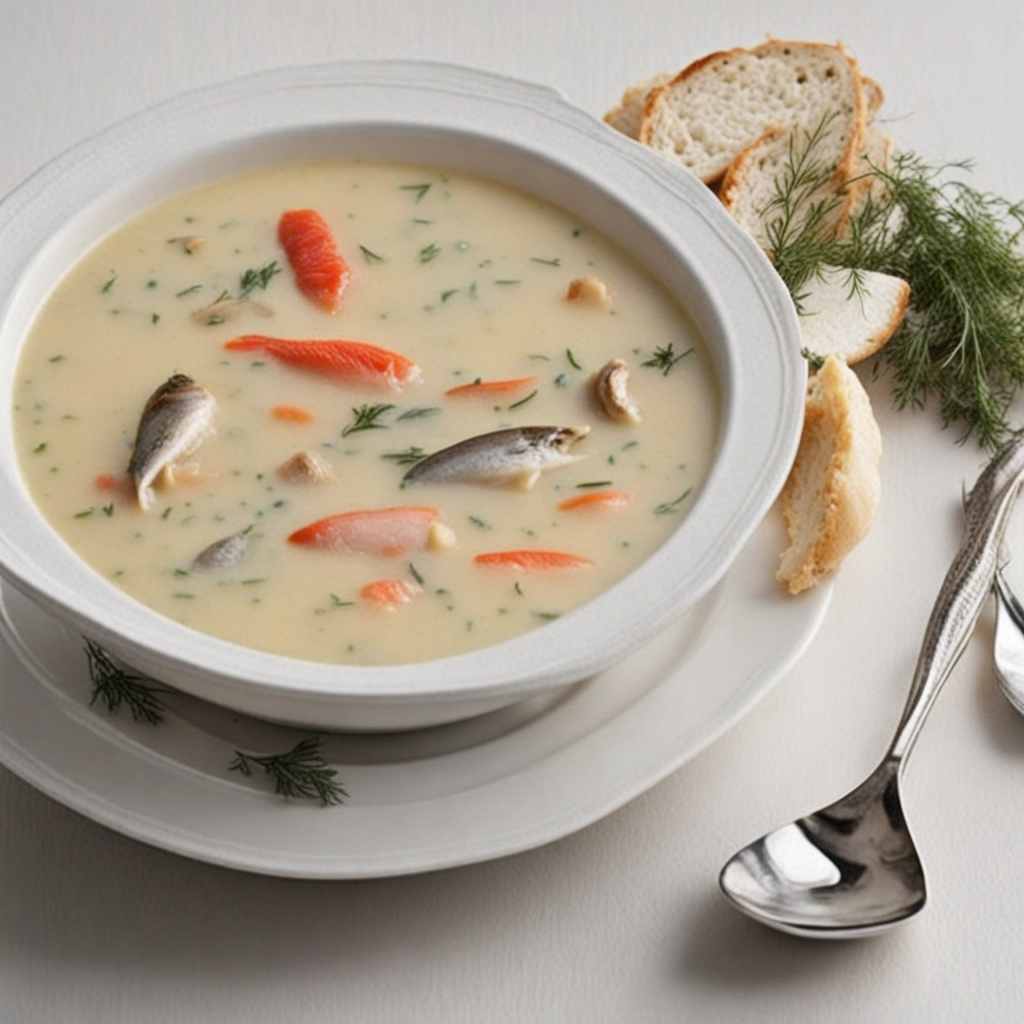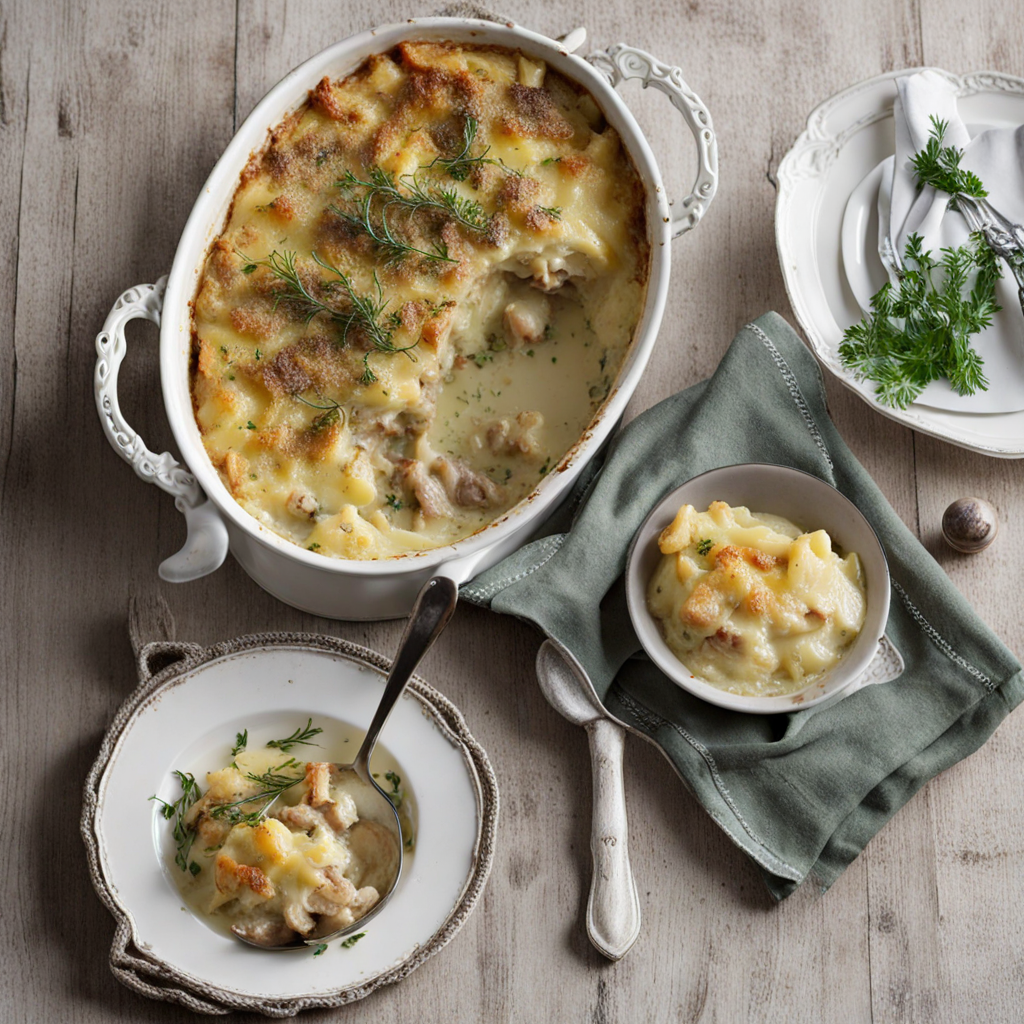Swedish Fish Soup
Swedish Fish Soup is a delightful and whimsical dish that combines the playful essence of candy with the comforting warmth of a traditional soup. The base of this unique creation typically consists of a vibrant broth infused with a medley of aromatic herbs and spices, giving it a fragrant quality that is both inviting and intriguing. As the soup simmers, it transforms into a captivating blend of flavors, with a hint of sweetness that evokes the taste of the beloved gummy candies it is named after. This unexpected combination of savory and sweet creates a harmonious balance that is sure to surprise and delight adventurous eaters. In addition to the aromatic broth, Swedish Fish Soup often includes an array of colorful vegetables that add texture and freshness to the dish. Carrots, bell peppers, and leeks may be diced and tossed into the pot, enhancing the overall visual appeal while providing a satisfying crunch. The vibrant colors of the vegetables contrast beautifully against the backdrop of the broth, making it a feast for the eyes as well as the palate. Each spoonful offers a delightful mix of flavors, as the natural sweetness of the vegetables complements the unique essence of the fish-shaped candies. This innovative soup is typically garnished with a sprinkle of fresh herbs, such as dill or parsley, which adds a touch of brightness and enhances the overall taste profile. The result is a dish that not only tantalizes the taste buds but also encourages a sense of nostalgia, reminiscent of childhood treats. Swedish Fish Soup is perfect for those looking to explore new culinary horizons, offering a playful twist on traditional soup while celebrating the joy of unique flavor combinations. It’s a dish that invites sharing and conversation, making it an ideal choice for gatherings and special occasions.
How It Became This Dish
The History of Fisksoppa: Sweden’s Beloved Fish Soup Origins and Early Beginnings Fisksoppa, a traditional Swedish fish soup, has its roots deeply embedded in the coastal communities of Scandinavia, where fishing has been a way of life for centuries. The word "fisksoppa" itself translates simply to "fish soup," a fitting title for a dish that has been a staple in the diets of Sweden’s coastal inhabitants for generations. The earliest references to fish soups can be traced back to the Viking Age (circa 800-1100 AD), when Norse seafarers relied heavily on the bounty of the sea for sustenance. During this time, fish was not only a primary source of protein but also a means of trade and economic stability. The Vikings, known for their seafaring prowess, developed a variety of methods to prepare and preserve fish, which included drying, smoking, and salting. These techniques laid the groundwork for the various fish-based dishes that would emerge in Scandinavian cuisine, including fisksoppa. Cultural Significance Fisksoppa is more than just a dish; it is a reflection of Sweden's rich maritime heritage and its deep connection to the sea. The soup is often made with a variety of fresh fish, such as cod, salmon, or perch, and is typically enhanced with a medley of vegetables, herbs, and spices. This combination not only highlights the diversity of the waters surrounding Sweden but also showcases the importance of seasonal and local ingredients in Swedish cooking. The soup holds a special place in Swedish culture, often featured during festive occasions and gatherings. It is particularly popular in the spring and summer months, when fresh fish is plentiful. Fisksoppa is frequently served at Midsummer celebrations, a time when Swedes come together to celebrate the summer solstice, enjoying the long days and the bounty of nature. Moreover, fisksoppa embodies the concept of "lagom," a Swedish term that translates to "just the right amount." This philosophy emphasizes balance and moderation, which is mirrored in the soup’s harmonious blend of flavors and textures. It is a dish best enjoyed in a communal setting, reflecting Sweden's values of togetherness and hospitality. Development Over Time As Sweden entered the Middle Ages, the preparation of fisksoppa evolved to accommodate new ingredients and cooking methods. The introduction of spices from trade routes, such as pepper and saffron, began to influence the flavor profile of the soup. This period also saw the rise of culinary texts, with recipes for fisksoppa appearing in various cookbooks, promoting the dish beyond regional boundaries. By the 19th century, as industrialization transformed Sweden’s economy and society, fisksoppa began to take on new forms. Urbanization led to changes in dietary habits, and the traditional practice of fishing became less common for many Swedes. However, the soup retained its popularity, often being served in restaurants and homes alike. The use of cream and butter became more prevalent during this time, giving the soup a richer, more luxurious texture. The 20th century brought further changes, with the introduction of canned goods and convenience foods. While some traditionalists lamented the loss of fresh ingredients, fisksoppa adapted to these new realities. Canned fish and pre-prepared broths became available, making the dish more accessible to the average Swede. This shift reflected a broader trend in Swedish cuisine, where convenience began to play a significant role in meal preparation. Despite these changes, the essence of fisksoppa remained intact. Home cooks and chefs alike continued to honor the traditions of their ancestors, often adding personal twists to the classic recipe. Regional variations emerged, with coastal areas favoring local fish and ingredients. For example, in the archipelago of Gothenburg, fisksoppa might be made with a combination of shellfish and white fish, while in northern Sweden, it may incorporate freshwater fish like pike or trout. Modern Interpretations and Global Reach In recent decades, fisksoppa has experienced a renaissance, both in Sweden and abroad. As global culinary trends shifted towards sustainability and health-conscious eating, the soup has been embraced for its nutritious profile. Fish is a lean protein, and when paired with vegetables and herbs, fisksoppa offers a well-rounded meal that is both satisfying and wholesome. The rise of the "New Nordic Cuisine" movement, which emphasizes local, seasonal ingredients, has also breathed new life into traditional dishes like fisksoppa. Chefs are experimenting with innovative presentations and flavor combinations, often incorporating unexpected ingredients such as Asian spices or Mediterranean influences. This evolution showcases the adaptability of fisksoppa and its enduring relevance in contemporary cuisine. Moreover, fisksoppa has gained international recognition, often appearing on the menus of Swedish restaurants around the world. It has become a symbol of Swedish culinary heritage, enticing diners with its unique flavors and comforting nature. Food festivals and culinary events celebrate traditional Swedish dishes, allowing fisksoppa to shine as a representative of Sweden’s rich gastronomic culture. Conclusion Fisksoppa is a dish that encapsulates the essence of Sweden's maritime history, cultural values, and culinary evolution. From its humble beginnings as a sustenance staple for fishermen to its status as a beloved dish enjoyed in homes and restaurants alike, fisksoppa remains a testament to the enduring nature of traditional cuisine. As Sweden continues to embrace its culinary heritage while adapting to modern tastes, fisksoppa will undoubtedly remain a cherished symbol of the country’s rich cultural tapestry for generations to come. In essence, fisksoppa is not just a fish soup; it is a narrative of the land, the sea, and the people who call Sweden home—an edible testament to their history, resilience, and communal spirit.
You may like
Discover local flavors from Sweden







